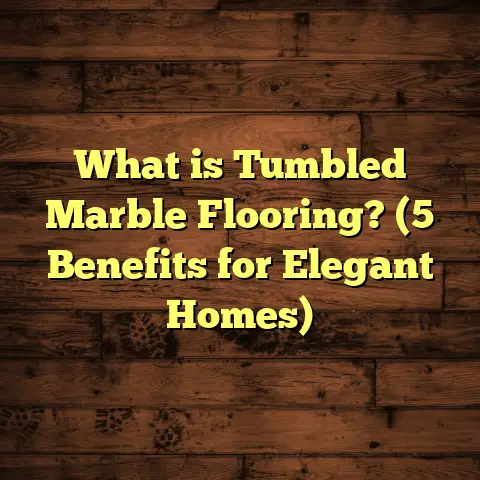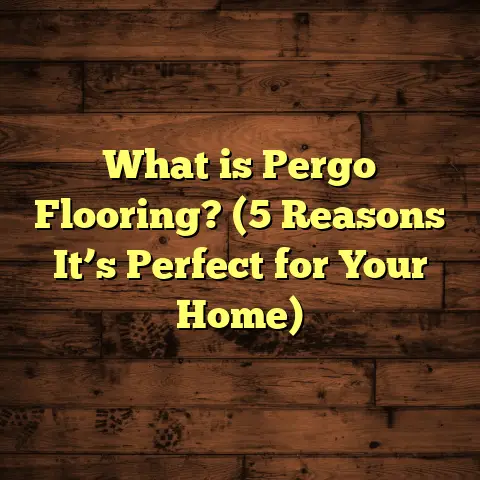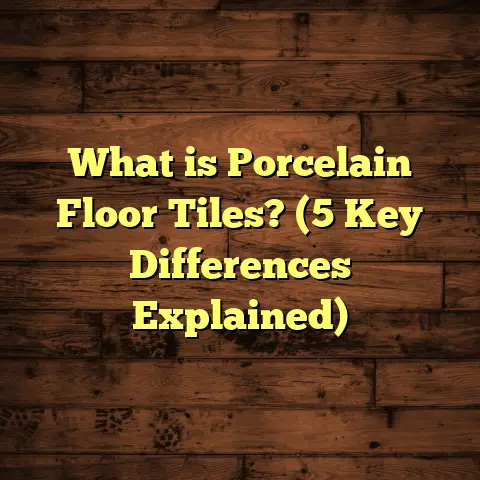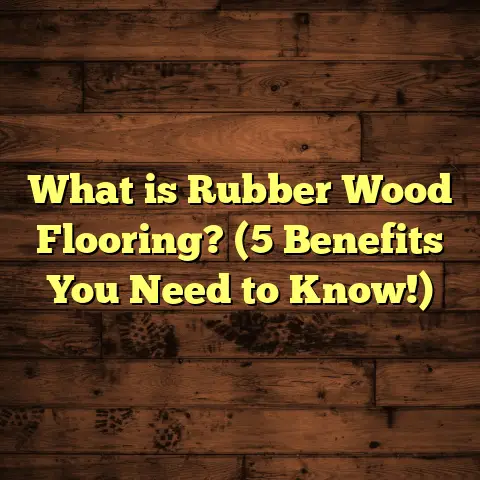What is Floor Design? (5 Key Elements for Your Home)
The way we think about floor design has changed a lot over the past few years. I’ve noticed that more people want their floors to do more than just cover the ground—they want floors that bring personality, warmth, and practicality into their homes. And honestly, after working in flooring for over a decade, I’ve seen how the right floors can completely transform a space. I’m excited to share everything I’ve learned about floor design with you. Whether you’re renovating or building new, understanding floor design can help you make choices that really make your home shine.
What is Floor Design?
Let’s start with the basics. What exactly is floor design? Simply put, floor design is the process of planning and creating the look and function of the floors in your living space. But it’s a lot more than just picking a material and laying it down. It’s about choosing the right materials, colors, patterns, textures, and finishes to create a floor that reflects your lifestyle and aesthetic.
Floor design is where art meets function. It’s where you think about how your floors will wear over time, how they feel underfoot, and how they interact with light and furniture. It’s also about how the floors complement the rest of your home’s design—from walls and ceilings to furnishings and decor.
When I work with clients, I often say that good floor design is like creating the foundation of a story in your home. It sets a tone without saying a word. The right floor choice can make a cozy cottage feel inviting or a modern loft feel sleek and polished.
Why Floor Design Deserves Your Attention
Have you ever walked into a room and immediately felt either relaxed or energized? Floors play a huge role in that feeling, even if we don’t always notice it consciously. Because floors take up so much visual space and are touched daily, they influence the mood and comfort of every room.
Here’s something interesting: According to the National Wood Flooring Association, installing hardwood floors can increase your home’s resale value by up to 2.5%. That’s not just about looks—it’s about the perceived quality and durability that good flooring offers.
Another report from the Home Improvement Research Institute showed that 38% of potential buyers consider flooring upgrades to be one of the most important factors when buying a home. This tells me people know floors matter—a lot.
Floor design influences practical things too, like:
- How easy it is to clean
- How safe it is for kids or elderly family members
- How well it handles moisture or heavy foot traffic
So, what goes into great floor design? I break it down into five key elements that I always focus on with my clients.
1. Material Selection: Finding Your Perfect Fit
Picking the right material is the first—and often most important—step in floor design. Material choice affects everything: durability, maintenance, comfort, appearance, and cost.
I’ve worked on projects with every type of flooring imaginable—from rustic reclaimed hardwoods to ultra-modern polished concrete. Each has its place depending on what you need.
Hardwood Flooring: Timeless and Durable
Hardwood floors are probably what most people picture when they think “flooring.” Wood offers natural warmth, character, and longevity.
I remember working with a family who chose reclaimed oak for their living room floors. The wood had unique knots and grain patterns that made their space feel full of history—and they loved knowing their floors were environmentally friendly too.
Hardwood floors can last decades if cared for properly. Species like white oak or maple are very durable. Plus, hardwood can be sanded and refinished multiple times to remove scratches or dents.
Data point: Hardwood floors typically last 25-100 years depending on species and maintenance. That kind of lifespan makes them a solid long-term investment.
Laminate Flooring: Affordable and Practical
Laminate flooring has evolved a lot. It started as a budget-friendly alternative to hardwood but now can look very realistic thanks to detailed photographic layers.
Laminate is easy to install (often click-lock systems), resistant to scratches and stains, and great for high traffic areas.
I’ve recommended laminate to clients who want the look of wood but have pets or kids because it resists damage better than softer woods.
One downside? Laminate doesn’t handle moisture well, so I avoid it in bathrooms or basements unless it’s specifically rated for moisture resistance.
Vinyl Flooring: Versatile and Waterproof
Vinyl flooring has had a major makeover in recent years. Luxury Vinyl Planks (LVP) now mimic wood textures so well many people can’t tell the difference without touching them.
Vinyl is waterproof, making it perfect for kitchens, bathrooms, mudrooms—anywhere spills or moisture are common.
In fact, vinyl sales have grown by 15% annually over the last five years due to this versatility.
Some clients even mix vinyl with other materials to get both durability and style where needed most. For example, vinyl in the kitchen paired with hardwood in adjacent rooms.
Tile Flooring: Durable and Design-Friendly
Ceramic or porcelain tile floors are incredibly tough and water-resistant. They’re ideal for wet areas but can also add artistic flair through patterns or mosaics.
I recall helping a client choose large-format porcelain tiles with subtle veining for their bathroom floor—it looked like marble but was far more affordable and durable.
Tiles come in endless colors, sizes, shapes, and finishes. They’re great if you want a custom look or need something hardy.
Carpet: Comfort Underfoot
Carpet brings softness and warmth that hard surfaces can’t match. It’s great for bedrooms or living areas where you want extra comfort and noise reduction.
However, it requires more maintenance—regular vacuuming and occasional deep cleaning—to stay fresh.
From my experience, families with kids love carpeted playrooms because it cushions falls and reduces noise levels considerably.
2. Color and Finish: Setting the Mood
Let’s talk color because it plays such a big role in how your floor feels emotionally.
I’ve seen rooms transform just by switching from dark walnut floors to light ash tones—or vice versa.
Light Colors: Make Spaces Feel Larger
Light-colored floors reflect more light which can make small rooms feel more open and airy.
If you live in a city apartment or have limited natural light, light floors can brighten things up beautifully.
Dark Colors: Create Warmth and Drama
Dark floors absorb light but add depth and coziness. They work well in large spaces or rooms where you want a rich, intimate vibe.
Be aware though—dark floors show dust and scratches more easily than lighter ones.
Neutral Tones: The Safe Bet
Neutral shades like beige, gray, or natural wood tones give you flexibility in decorating since they blend with nearly any style or color palette.
They’re also less likely to feel outdated quickly compared to very bold colors.
Finish Types: Matte vs Glossy
Finish affects not just look but practical aspects:
- Matte finishes hide scratches better because they don’t reflect much light.
- Glossy finishes brighten rooms by reflecting light but show imperfections more clearly.
One client once told me she regretted picking glossy floors in her busy entryway because every scratch was visible almost immediately.
3. Pattern and Layout: Adding Character
Choosing how your flooring is laid out can change everything about its impact on your space.
Straight Lay: Simple & Classic
This is the most common layout—boards or tiles installed parallel to walls. It’s clean, timeless, and works anywhere.
Herringbone: Elegant Zigzag
Herringbone features rectangular boards arranged in a zigzag pattern at 90 degrees. It adds movement and sophistication without overwhelming a space.
I had a client who wanted something special for their dining room. We installed herringbone oak planks that became an instant conversation piece for guests.
Chevron: Pointed Arrow Pattern
Similar to herringbone but with boards cut at angles so ends meet perfectly—creates a sharper “V” shape.
It feels more modern but still classic enough for traditional homes.
Diagonal Layout: Angled Boards
Boards installed at 45 degrees can visually expand small rooms by drawing eyes outward along diagonal lines.
4. Texture: Touch & Feel Matter
Texture influences comfort underfoot as well as safety—especially in wet areas.
Smooth vs Textured
Smooth polished floors look sleek but can be slippery when wet. Textured surfaces provide grip but might trap dirt easier.
In kitchens or bathrooms, I always recommend textured tiles or vinyl with embossed finishes for better traction.
For bedrooms or living rooms, softer textures like brushed hardwood or low-pile carpet offer warmth underfoot without sacrificing style.
Combining Textures
One project I loved involved pairing polished concrete floors with layered area rugs. The contrast between cold smoothness and soft textiles made the space feel balanced yet interesting.
5. Functionality: Matching Floors to Lifestyle
The most beautiful floor means nothing if it doesn’t fit how you live daily.
I always ask clients:
- Do you have pets or kids?
- How much foot traffic will this floor get?
- Will there be spills or moisture exposure?
- How much time do you want to spend cleaning?
These answers steer me toward practical choices that hold up over time without causing headaches later on.
For example, families with young kids often choose waterproof vinyl planks because they are scratch-resistant, stain-proof, and easy to clean.
One case study from my own work was a family of five who picked waterproof laminate for their playroom. After two years of heavy use—spilled juice, muddy shoes, paint projects—the floors still looked new because they handled wear so well.
How These Elements Work Together
When I take on a flooring project, I don’t think about these elements separately—they all intertwine to create a cohesive design tailored for each home’s unique needs.
Think of it like putting together an outfit:
- Material = fabric type
- Color = color scheme
- Pattern = clothing cut/style
- Texture = fabric finish
- Functionality = comfort & practicality
For example:
- A minimalist might opt for light-colored engineered hardwood laid straight with matte finish.
- Someone seeking cozy vibes could choose warm-toned carpet paired with soft rugs.
- A busy household might favor dark vinyl planks in herringbone with textured finish for durability plus style.
Some Surprising Stats About Flooring Choices
Let me share some data from recent industry research that shows how flooring trends are evolving:
- Hardwood remains popular but luxury vinyl plank sales have grown by over 15% annually due to waterproof features.
- 60% of homeowners say flooring was their #1 priority when remodeling kitchens or bathrooms (National Kitchen & Bath Association).
- According to Houzz 2023 data, 45% of families preferred vinyl flooring because it’s easy to maintain around kids.
- The average lifespan of hardwood floors ranges from 25 years (softwoods) up to 100+ years (some hardwood species).
These stats tell me people care about both style and functionality—exactly what good floor design delivers.
Personal Stories From My Flooring Projects
I want to share some real-life flooring stories that stick with me:
Story 1: A couple building their dream home wanted something sustainable yet stylish. We sourced reclaimed barn wood for their floors. Not only did it give their home character, but they loved knowing they were reusing materials instead of cutting down new trees. Plus it was durable enough for their two energetic dogs!
Story 2: A retiree wanted low-maintenance flooring that felt warm underfoot but wouldn’t require constant upkeep. We went with wide-plank engineered hardwood finished with matte oil-based stain. It looked natural but resisted scratches well—and she said walking barefoot felt like heaven compared to her old tile floors.
Story 3: A family with three kids needed waterproof flooring throughout their main living area including kitchen. We installed luxury vinyl plank in herringbone pattern with subtle wood grain texture. They loved how easy cleanup was after spills—and guests kept complimenting the pattern!
Maintenance Tips Tied to Design Choices
Designing your floor well also means planning for care:
- Hardwood: Sweep regularly; avoid water spills; refinish every 7-10 years depending on wear.
- Laminate: Use dry mop; avoid abrasive cleaners; replace damaged planks.
- Vinyl: Sweep/mop frequently; use gentle cleaners; watch for sharp objects.
- Tile: Grout cleaning is key; seal grout annually; use rugs near water sources.
- Carpet: Vacuum often; deep clean yearly; spot treat stains immediately.
I always tell clients: Think about maintenance before you buy—it saves headaches later!
Some Design Trends I’m Loving Right Now
Here are some flooring trends I’m seeing pop up in homes I work on:
- Wide planks: They create an open feel and highlight wood grain better.
- Mixed materials: Combining tile and wood or vinyl to define spaces without walls.
- Natural tones: Earthy browns, soft grays, warm beiges are popular over bold colors.
- Textured vinyl: Embossed finishes on vinyl mimic natural materials closely.
- Patterned tiles: Geometric shapes or Moroccan-inspired patterns add flair especially in bathrooms/kitchens.
Personally, I love helping clients mix classic materials like hardwood with trendy accents like patterned tiles—it keeps things fresh without feeling fleeting.
Questions You Should Ask When Planning Floor Design
If you’re thinking about new floors, here are some questions I recommend:
- What’s my budget including installation?
- What kind of foot traffic will this area get?
- Do I need waterproof or scratch-resistant materials?
- How much time do I want to spend cleaning?
- What colors/patterns do I love? Will they fit my overall decor?
- Do I want something timeless or trendy?
- Do I prefer warm/cozy or sleek/minimalist feels?
- Am I okay refinishing/upgrading later or want low maintenance?
Answering these will help narrow down choices so you don’t get overwhelmed by options—which trust me can happen fast!
Final Thoughts From Me on Floor Design
Floor design isn’t just about putting something underfoot—it’s about creating a foundation for your whole home experience. When done right, floors set the mood, improve comfort, boost value, and withstand life’s messes gracefully.
If you’re ready to take on your next flooring project, think about these five elements:
- Material
- Color & finish
- Pattern & layout
- Texture
- Functionality suited to your lifestyle
Feel free to reach out if you want help tailoring choices specifically for your home—I’m always happy to talk floors!
Remember: Your floor is literally where your day begins and ends—make it something worth stepping on every single time.





